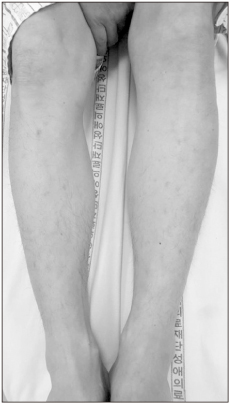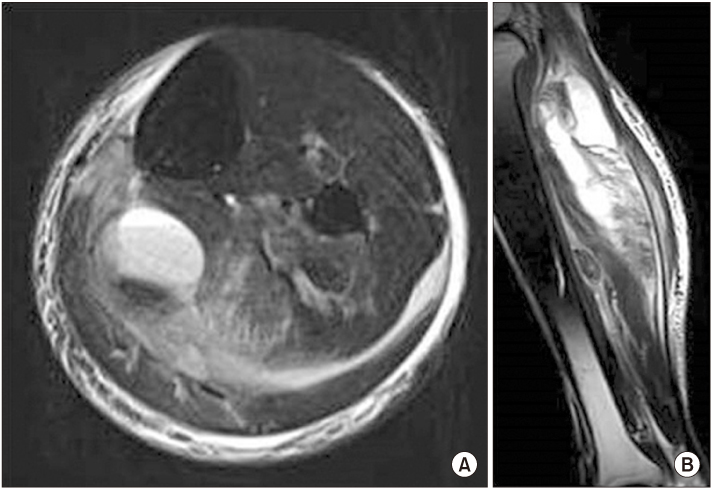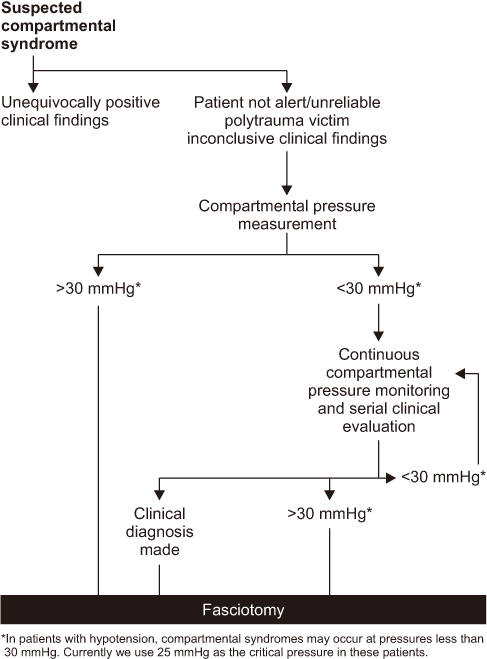J Korean Orthop Assoc.
2019 Apr;54(2):177-181. 10.4055/jkoa.2019.54.2.177.
Acute Compartment Syndrome after Anticoagulant Therapy to Misdiagnosed Deep Vein Thrombosis
- Affiliations
-
- 1Department of Orthopedic Surgery, Sung-Ae Hospital, Seoul, Korea. j9422hs@hanmail.net
- KMID: 2444784
- DOI: http://doi.org/10.4055/jkoa.2019.54.2.177
Abstract
- Acute compartment syndrome, which is an orthopedic emergency, induces irreversible tissue necrosis by increasing the compartment pressure. In serious cases, this event may result in functional impairment, loss of the lower limb, and death by renal failure. When the patient initially presents with pain and swelling that are similar to deep vein thrombosis, a differential diagnosis between the two diseases is very critical. The authors encountered a case of acute compartment syndrome after anticoagulant therapy in a patient presenting with painful swelling of the left leg following a massage that was initially misdiagnosed as deep vein thrombosis. A fasciotomy was performed on this case with satisfactory results. This paper reports this case with a review of the relevant literature.
MeSH Terms
Figure
Reference
-
1. Mauser N, Gissel H, Henderson C, Hao J, Hak D, Mauffrey C. Acute lower-leg compartment syndrome. Orthopedics. 2013; 36:619–624.
Article2. Von Keudell AG, Weaver MJ, Appleton PT, et al. Diagnosis and treatment of acute extremity compartment syndrome. Lancet. 2015; 386:1299–1310.
Article3. Oh CW, Lee HJ. Acute compartment syndrome after trauma. J Korean Fract Soc. 2010; 23:399–403.
Article4. Fulkerson E, Razi A, Tejwani N. Review: acute compartment syndrome of the foot. Foot Ankle Int. 2003; 24:180–187.
Article5. Bourne RB, Rorabeck CH. Compartment syndromes of the lower leg. Clin Orthop Relat Res. 1989; 240:97–104.
Article6. Ackermann PW, Labruto F, Weiss RJ, Jansson KÅ. Increasing thigh pain: acute compartment syndrome! BMJ Case Rep. 2010; 2010:pii: bcr12.2009.2513.
Article7. Bonner L, Johnson J. Deep vein thrombosis: diagnosis and treatment. Nurs Stand. 2014; 28:51–58. quiz 60.
Article8. Lopez GJ, Hoffman RS, Davenport M. Plantaris rupture: a mimic of deep venous thrombosis. J Emerg Med. 2011; 40:e27–e30.
Article9. Hiraga A, Nakagawa Y, Kamitsukasa I, Suzuki T, Kuwabara S. Muscle haematoma due to antithrombotic treatment for ischaemic stroke. J Clin Neurosci. 2015; 22:1160–1163.
Article10. Peterson DA, Kazerooni EA, Wakefield TW, et al. Computed tomographic venography is specific but not sensitive for diagnosis of acute lower-extremity deep venous thrombosis in patients with suspected pulmonary embolus. J Vasc Surg. 2001; 34:798–804.
Article
- Full Text Links
- Actions
-
Cited
- CITED
-
- Close
- Share
- Similar articles
-
- The Occurence of Deep Vein Thrombosis in Abdominal Compartment Patient
- Compartment Syndrome Following Total Knee Arthroplasty: Clinical Results of Late Fasciotomy
- Antiphospholipid Syndrome Presented with Pulmonary Embolism and Deep Venous Thrombosis in Child
- Upper Extremity Deep Vein Thrombosis after Clavicle Fracture and Immobilization
- Deep Vein Thrombosis in May-Thurner Syndrome Patient after Operative Treatment of Acute Cauda Equina Syndrome: A Case Report






